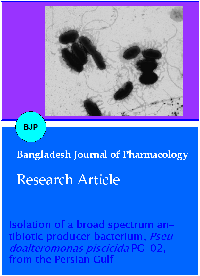Isolation of a broad spectrum antibiotic producer bacterium, Pseudoalteromonas piscicida PG-02, from the Persian Gulf
DOI:
https://doi.org/10.3329/bjp.v6i2.8592Keywords:
Antibacterial, Marine bacterium, MRSA, SedimentAbstract
The aim of this study was to isolation of marine antibiotic-producing bacteria from the Persian Gulf, as an untapped source for searching new natural drugs. Bioactivity of ethyl acetate extract prepared from marine bacterial isolates was evaluated against 21 human pathogenic bacteria. GCI (Growth Curve Interference) parameter was determined for the obtained marine antibiotic compound against MRSA (Methicillin resistant Staphylococcus aureus). Finally, identification of intended isolate was done based on phenotipically and phylogenetically characters. Overall, 49 bacterial colonies were isolated but only one isolate from coastal sediment identified as Pseudoalteromonas piscicida PG-02 showed antibacterial activity. It was effective against all of tested bacteria except Listeria monocytogenes (clinical), L. monocytogenes (ATCC 19112), Proteus mirabilis (clinical) and Klebsiella pneumoniae (clinical). GCI parameter was obtained with concentration just near to MIC (GCI: 20 mg/mL). In conclusion, this marine bacterium can give hopes for treatment of diseases caused by multidrug resistant (MDR) bacteria.
Downloads
509
350 Read
25
References
Agah H, Elskens M, Fatemi SMR, Owfi F, Baeyens W, Leermakers M. Mercury speciation in the Persian Gulf sediments. Environ Monit Assess. 2009; 157: 363-73.
Asthana RK, Deepali, Tripathi MK, Srivastava A, Singh AP, Singh SP, Nath G, Srivastava R, Srivastava BS. Isolation and identification of a new antibacterial entity from the Antarctic Cyanobacterium Nostoc CCC 537. J Appl Phycol. 2009; 21: 81-88.
Balcazar JL, Loureiro S, Silva YJD., Pintado J, Planas M. Identification and characterization of bacteria with antibacterial activities isolated from seahorses (Hippocampus guttulatus). J Antibiot. 2010; 63: 271-74.
Carvalho CCR, Fernandes P. Production of metabolites as bacterial responses to the marine environment. Mar Drugs. 2010; 8: 705-27.
Castillo A, Liebana J, Lopez E, Baca P, Liebana JM., Liebana MJ, Castillo F. Interference of antibiotics in the growth curves of oral Streptococci. Int J Antimicrob Agents. 2006; 27: 263-66.
Darabpour E, Roayaei Ardakani M, Motamedi H, Ghezelbash G, Ronagh MT. Isolation of an antibiotic producer Pseudomonas sp. from the Persian Gulf. Asian Pac J Trop Med. 2010; 3: 318-21.
Das S, Lyla PS, Ajmal Khan S. Marine microbial diversity and ecology: Importance and future perspectives. Curr Sci. 2006; 90: 1325-35.
Garrity GM, Bell JA, Lilburn TI. Pseudoalteromonas. In: Bergey's manual of systematic bacteriology. Bownan JP, McMeekin TA (eds). 2nd ed. New York, Springer, 2006, pp 467-77.
Isnansetyo A, Istiqomah I, Muhtadi, Sinansari S, Hernawan RK, Widada J. A potential bacterial biocontrol agent, strain S2V2 against pathogenic marine Vibrio in aquaculture. World J Microbiol Biotechnol. 2009; 25: 1103-13.
Kanoh K, Adachi K, Katsuta A, Shizuri Y. Structural determination and proposed biosynthesis of alcanivorone, a novel a-pyrone produced by Alcanivorax jadensis. J Antibiot. 2008; 61: 70-74.
Long RA, Azam F. Antagonistic interactions among marine pelagic bacteria. Appl Environ Microbiol. 2001; 67: 4975-83.
Long RA, Qureshi A, Faulkner DJ, Azam F. 2-n-Pentyl-4-quinolinol produced by a marine Alteromonas sp. and its potential ecological and biogeochemical Roles. Appl Environ Microbiol. 2003; 69: 568-76.
McCarthy SA, Johnson RM, Kakimoto D. Characterization of an antibiotic produced by Alteromonas luteoviolacea Gauthier 1982, 85 isolated from Kinko Bay, Japan. J Appl Bacteriol. 1994; 77: 426-32.
Motamedi H, Darabpour E, Gholipour M, Seyyed Nejad SM. In vitro assay for the anti-brucella activity of medicinal plants against tetracycline-resistant Br. melitensis. J Zhejiang Univ Sci B (Biomed Biotechnol). 2010; 11: 506-11.
Mulks MH, Nair MG, Putnam AR. In vitro antibacterial activity of Faeriefungin, a new broad-spectrum polyene macrolide antibiotic. Antimicrob Agents Chemother. 1990; 34: 1762-65.
Oku N, Kawabata K, Adachi K, Katsuta A, Shizuri Y. Unnarmicins A and C, new antibacterial depsipeptides produced by marine bacterium Photobacterium sp. MBIC06485. J Antibiot. 2008; 61: 11-17.
Papizadeh M, Roayaei Ardakani M, Ebrahimipour G, Motamedi H. Utilization of dibenzothiophene as sulfur source by Microbacterium sp. NISOC-06. World J Microbiol Biotechnol. 2010; 26: 1195-1200.
Saitou N, Nei M. The neighbor-joining method: A new method for reconstructing phylogenetic trees. Mol Biol Evol. 1987; 4: 406-25.
Shankar CVS, Malar AHJ, Punitha SMJ. Antimicrobial activity of marine bacteria associated with polychaetes. Biores Bull. 2010; 1: 24-28.
Shibl AM, Sowaygh AL. Antibiotic inhibition of protease production by Pseudomonas aeruginosa. J Med Microbiol. 1980; 13: 345-49.
Talaro KP. Foundations in microbiology. 7th ed. New York, McGraw Hill, 2009.
Teasdale ME, Liu J, Wallace J, Akhlaghi, F, Rowley DC. Secondary metabolites produced by the marine bacterium Halobacillus salinus that inhibit Quorum sensing-controlled phenotypes in Gram-negative bacteria. Appl Environ Microbiol. 2009; 75: 567-72.
Tenover FC. Mechanisms of antimicrobial resistance in bacteria. Am J Med. 2006; 119: S3-S10.
Yeon SH, Jeong WJ, Park JS. The diversity of culturable organotrophic bacteria from local solar salterns. J Microbiol. 2005; 43: 1-10.

Published
How to Cite
Issue
Section
License
Authors who publish with this journal agree to the following terms:
- Authors retain copyright and grant the journal right of first publication with the work simultaneously licensed under a Creative Commons Attribution License that allows others to share the work with an acknowledgement of the work's authorship and initial publication in this journal.
- Authors are able to enter into separate, additional contractual arrangements for the non-exclusive distribution of the journal's published version of the work (e.g., post it to an institutional repository or publish it in a book), with an acknowledgement of its initial publication in this journal.
- Authors are permitted and encouraged to post their work online (e.g., in institutional repositories or on their website) prior to and during the submission process, as it can lead to productive exchanges, as well as earlier and greater citation of published work (See The Effect of Open Access).
